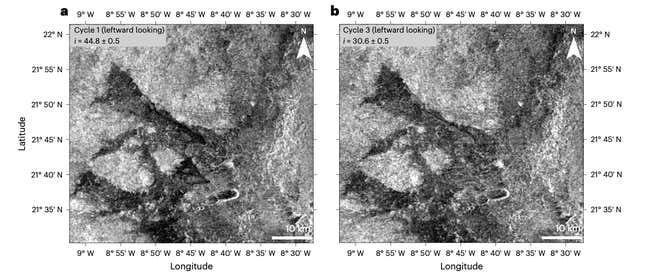The surface of Venus is littered with thousands of volcanoes, some of which may still be active until today. A fresh look at 30-year-old radar images captured by the Magellan spacecraft revealed new lava flows on Venus, suggesting that the planet was volcanically active between 1990 to 1992.
NASA Delays Return to Earth’s Evil Twin, Venus
NASA’s Magellan mission arrived at Venus in 1990 and became the first spacecraft to image the entire surface of the planet before plunging into the Venusian atmosphere on October 12, 1994. Since its dramatic ending, no other spacecraft has been dedicated to exploring Venus. Although the radar images captured by Magellan are more than three decades old, scientists have developed new instruments to probe at the data and weave new discoveries about the hellish planet.
Thirty-two year old Davide Sulcanese, a graduate student at the Università d’Annunzio in Italy and lead author of a new paper on Venus’ volcanism, jokes that the radar images examined by him and his team are of his exact age. “This is very old data but with the new technology, we can still make it very useful even for new discoveries,” Sulcanese told Gizmodo.
The team poured over two sets of Magellan radar data obtained in 1990 and 1992 to look for evidence of volcanic activity. In the images, team members found surface changes in two areas, the western flank of Sif Mons, a volcano on Venus, and in western Niobe Planitia, a large volcanic lowland province on the planet. Scientists have previously found volcanic-related features on both of those areas, but the team behind the new study discovered variations in the radar backscatter between different images taken by Magellan over a period of two years. The variations are likely indicative of new lava flows on the surface of Venus, according to the study published in Nature Astronomy.

The new findings not only support an earlier study on Venus’ volcanic activity, but also suggest that present-day volcanism on Venus is rather widespread. In March 2023, a group of scientists found a volcanic vent on Venus changing shape and increasing significantly in size in less than a year.
That was the first indication of recent volcanic activity on Venus, but now scientists can better understand the scale of Venus’ volcanism. “Our findings allowed us to estimate the flow rate, and it turned out that Venus is actually much more active than expected and the level of of activity is comparable, or similar, to Earth ,” Sulcanese said.
Studying active volcanoes can help scientists understand how a planet’s interior can shape its crust and affect its habitability over the years. Venus is sometimes referred to as Earth’s twin because both planets are almost the same size and mass, and have similar composition.
“By studying Venus, we can better understand Earth,” Sulcanese said. “It’s a volcanic world so it’s a very hostile environment, at least to us…I hope not, but maybe this is something that will happen to Earth.”
It’s been a long time in the making, but NASA is finally sending a new mission to Venus. VERITAS, which is scheduled to launch no earlier than 2031, will study Venus’ surface and core to understand how a rocky planet about the same size as Earth evolved in a very different path.
More: How Did Water Escape From Venus? A New Study May Have Solved the Mystery






